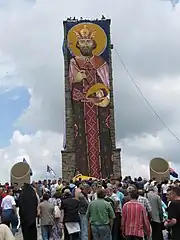Газиместан Gazimestani | |
 Gazimestan monument | |
| 42°41′26″N 21°7′25″E / 42.69056°N 21.12361°E | |
| Location | 5 km (3.1 mi) from Pristina, Kosovo |
|---|---|
| Designer | Aleksandar Deroko |
| Type | memorial, tower |
| Material | stone |
| Height | 25 m (82 ft) |
| Completion date | 1953 |
| Dedicated to | fallen Serbian soldiers at the Battle of Kosovo (1389) |
Gazimestan (Serbian Cyrillic: Газиместан, Serbian pronunciation: [ɡaziměstaːn], Albanian: Gazimestani) is the name of a memorial site and monument commemorating the Battle of Kosovo (1389), situated about 6-7 kilometres southeast of the actual battlefield, known as the Kosovo field. The name is a portmanteau derived from Arabic word “ghazi”, meaning “muslim warrior” and Persian word “stan” meaning "place of". Gazimestan is reached from the Pristina–Mitrovica highway, on a 50-metre hill above the plain, ca. 5 km north-west from Pristina. Every year, on Vidovdan (St. Vitus Day), 28 June, a commemoration is held by the monument, which in later years is also covered by an image of Prince Lazar, who led an army comprised by Serbian people.
History
In 1989, on the 600th anniversary, Serbian president Slobodan Milošević held the famous controversial speech Gazimestan speech that can be considered as the starting point for disintegration of Yugoslavia.
In 1997 the site was declared a cultural heritage of Serbia.[1]
Monument
The Gazimestan monument was designed by Aleksandar Deroko, in the shape of a medieval tower, and built in 1953 under the authority of FPR Yugoslavia, 556 years after the Battle of Kosovo.
 Vidovdan 2009
Vidovdan 2009 Vidovdan 2013
Vidovdan 2013
See also
References
- ↑ "Gazimestan". Spomenici. Republic of Serbia. Archived from the original on 2016-03-04. Retrieved 2017-04-25.
Sources
- Marković, Dragan (1989). "SVEČANOSTI NA GAZIMESTANU O VIDOVDANU IZMEĐU DVA SVETSKA RATA" (PDF). Etnološke sveske. 10: 127–134.
